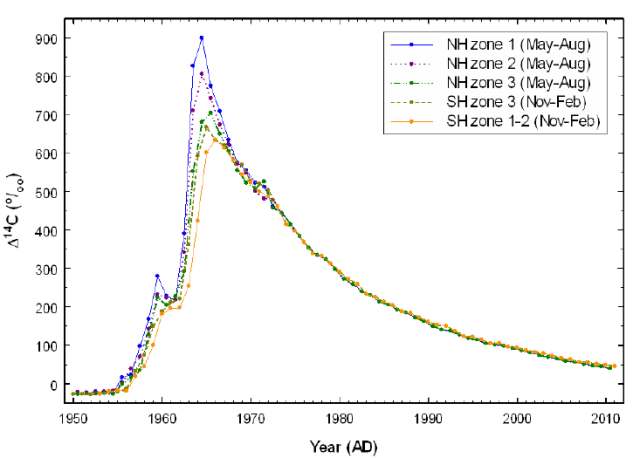Perhaps the easiest way to mislead your audience, or indeed yourself, is to generate deceptive graphics. Murry Salby is to be saluted for his mastery of this art, with several fine examples in his recent London lecture. Here are the best two.
The first example is a figure showing the changes in atmospheric 14C due to atmospheric nuclear bomb testing and the subsequent absorption of this 14C into the oceans and biomass. Salby is arguing that this occurs quickly.
“Within two decades the nuclear surplus of 14C was history”
Bomb-radiocarbon is a useful dating technique over the last 60 years, so I am familiar with the general shape of the curve and something is wrong with Salby’s figure – it shows atmospheric 14C to have declined to its original value within 20 years of the 1963 test ban treaty. In reality, 14C concentrations remain above background 50 years later. Comparing Salby’s version with the correct data, it becomes obvious (OK, Cathy worked it out first) what he has done.
Rather than showing the whole curve, Salby starts his curve in 1958 after many bomb tests have been conducted. His background level of 14C is therefore much higher than the true background level. This makes it appear that the bomb 14C moved out of the atmosphere much faster than it really did. These shenanigans would have been obvious had he extended his figure to the present day as he would have had negative 14C values, and the poor fit of his exponential curve would have been exposed.
Salby’s claim that 14C levels declined to background within 20 years is bogus, his graph is exceptionally deceptive.
The second example is a figure Salby uses to argue that emissions are a function of population as the two curves overlie each other since 1860. If we accept this claim, it implies that population control rather than emissions abatement is needed.
There is just the little problem of the scale of the two curves. The emissions scale starts at zero, the population curve starts at about one billion. The two curves only overlie because of this scaling trick. A fair plot would show that emissions have risen much faster than population, over this time period. Does Salby really think that per-capita emissions in 1860 (horse-drawn ploughs, etc) were equal to those of 2010? The data suggest otherwise.
Is Salby aware of his skill in constructing deceptive figures? Certainly his audiences are not.




 @richardjtelford
@richardjtelford
You may have seen this one, but it’s also a classic. As far as C14 is concerned, I had always assumed that it would decay faster than the timescale over which a pulse of excess CO2 would decay, because when a CO2 molecule with C14 is absorbed by one of the natural sinks it will probably be replaced by a non-C14 CO2 molecule. Is that roughly right?
Fiddling axis scales seems to be Salby’s main skill. That and presenting it with a straight face – it takes lots of practice.
Your interpretation of the C14 absorption is roughly correct.
Indeed, the C14 observations can be used as an estimate of the residence time, but not the adjustment time. Prof Salby doesn’t seem to make a distinction between the two, which is a mistake that was previously made by Prof. Essenhigh (my comment on his paper can be found here http://pubs.acs.org/doi/abs/10.1021/ef200914u . Of course the important distinction between residence (turnover) and adjustment time is clearly explained in the first IPCC WG1 report, in this case you only need to make it as far as page 8:
“The turnover time of CO2 in the atmosphere, measured as the ratio of the content to the fluxes through it, is about 4 years. This means that on average it takes only a few years before a CO2 molecule in the atmosphere is taken up by plants or dissolved in the ocean. This short time scale must not be confused with the time it takes for the atmospheric CO2 level to adjust to a new equilibrium if sources or sinks change. This adjustment time, corresponding to the lifetime in Table 1.1, is of the order of 50–200 years, determined mainly by the slow exchange of CO2 between surface waters and the deep ocean. The adjustment time is important for the discussion on global warming potential.”
The first IPCC report is much more accessible than later editions, and still an excellent resource for looking into the basic issues (provided you accept that the numbers are likely to have changed a bit as the result of the scientific progress made since then).
With this kind of graphical deception, I think Salby better not want an academic job back. This is the type of data (mis)representation that could (should?) lead to an accusation of scientific misconduct.
Salby gets ~10-person audience, sponsored by the PSI “slayers”. He did at least one other talk, for EIKE in Germany.
Actually, I think it would be terrifuc if he’d visit the US for a public talk, maybe for Heartland or even better back in Colorado. I might even fly over to watch.
ICYMI here’s a graphic suitable for such circumstances:
Thanks for spotting his ‘trick’ (TM)
I was surprised when I saw his presentation because I’d done this myself and got a very good fit and clearly his exponential was not a very good fit. Also his timeconst was surprisingly short.
My main time const was 17 years not 8.6 !
Salby is con-man, IMO. A used-car salesman. If he has something credible he should put it down on paper and publish it, at least on-line, where it would be open to inspection instead of playing around with videos of slide presentations.
It is very easy to mislead in a slide presentation even it you bang a few sciency looking equation on the screen. He said about 3 years ago that a paper was “imminent” , we are still waiting.
Having said that there is a strong relationship between rate of change of CO2 and SST that needs to be acknowledged and explained.
Which relationship between the rate of change of CO2 and SST to you refer to? The one driven by El Nino? This has been understood for decades.
For some ‘recent’ examples see:
Click to access bg-5-1601-2008.pdf
http://dx.doi.org/10.1111/j.1600-0889.2005.00159.x
http://onlinelibrary.wiley.com/doi/10.1029/2005GL023027/full
And if Greg is also interested in older ones he may want to try to get a hold of some papers from Charles Keeling from the early 1980s.
Indeed, there is some discussion of this towards the end of the SkS article I wrote explaining Prof. Salby’s error with respect to the correlation http://www.skepticalscience.com/salby_correlation_conundrum.html (see section “What does Mainstream Science say about all this?”).
Looking at both Salby’s Absorption of CO2 graph and the graph you show are really exactly the same (granted yours has a longer timeframe). If you look at his and your graph, both show the same return after 20 years (1961 to 1981). Salby never said C14 returned to normal levels (however, he did show, as does your graph show, that C14 levels in 1981 returned to 1961 levels). He was purely using the graph to show Absorption of C(14)O2 from the atmosphere vice how quickly it was really removed from atmosphere (observed on his subsequent graph you do not show) meaning if it was not absorbed quickly (into soil/ocean), one would expect to see it follow the graph you (and he) show. C(14)O2 was out of the atmosphere much quicker meaning it was absorbed much quicker than 20 years.
With Regards to Fossil Fuel Emission graph, Salby’s graph shows about 9 GtC/yr by around 2010. Your graph you link to shows 9000 million metric tons of Carbon/year. Exactly the same number. 1940 and 1860 numbers are also the same. Sure he laid population over that number and compressed the billions of population numbers to show a correlation. In this case, unlike CO2 levels and subsequent warming, there is also an actual causation since we, humans, get fossil fuel out of the ground and burn it for energy.
So, I am confused as to what you believe you have found.
“Within two decades the nuclear surplus of 14C was history” – how can that be anything other than a claim that 14C returned to natural levels. His graph is misleading – it appears to show natural levels being reached after only 20 years.
Plotting two sets of data on the same graph with different scales is a well known way to generate misleading plots. Salby managed it here, misdirecting the audience to believe that population control is more important than emissions control.
The C-14 has reached a new equilibrium distribution among the reservoirs and the bomb test pulse has raised the background levels until the C-14 beta decays over subsequent 50k years. Salby is not wrong. The initial concentration peak displays a strong driving force to disperse among the reservoirs which slows as the concentrations come to a new equilibrium. One must keep in mind the material balance even though the amounts of C-14 are small they do reflect the bulk exchange of CO2. We must also include the natural ongoing formation of C-14 in the atmosphere and the release of C-14 from the civilian nuclear power plant fuel cycle that biases the baseline upwards starting about the time the above ground bomb tests stopped. There is no reason not to expect pulses of fossil fuel combustion to be similarly captured in the natural reservoirs. The problem is long term ongoing releases. Is there a point at which the reservoirs will slow down or even stop taking any additional CO2? This is an important question to answer, but the empirical data required to understand the system limits are not easily measured due to some very long time constants in ocean circulation and chemistry that we cannot be certain are stable over time. Salby in one of his other graphs points out how recent large increases in CO2 emissions do not give rise to a faster increase in atmospheric CO2 levels. This supports the idea that the reservoirs’ capture of CO2 is sensitive to concentration differentials which is what physical chemistry would predict. Even if we aren’t enamored of Salby’s style, we need to be complete in our own analysis.
Radiocarbon emissions from the nuclear industry (about 20% of natural 14C production) have certainly acted to stabilise atmospheric 14C concentrations, but the system is still far from equilibrium as the deep ocean will take hundreds of years to ventilate. None of this helps Salby’s argument and there is no reason to suspect that a pulse of CO2 will be absorbed by the ocean as fast as a pulse of 14C.
The increase in atmospheric CO2 is not constant, there is a gradual increase in rate that is entirely consistent with the increase in emissions with a ~constant airborne fraction.
Wrt to CO2-C14 clearance, the half life is about 10 years (just eying the data) and independent of starting concentration. I don’t see the problem. I doubt C12 and C14 would behave differently.
Individual molecules of 14CO2 and 12CO2 behave in a similar way. But the budgets are very different. There is a large reservoir of 12CO2 in the ocean and the flux of 12CO2 into the ocean is almost balanced by the flux out of the ocean. In contrast, there is much less 14CO2 in the ocean, so the fluxes into and out of the ocean are not in balance. Hence atmospheric 14CO2 concentration declines rapidly, but 12CO2 doesn’t.
This paper from 1956 calculates the 14CO2 atmospheric residence time of 7 to 10 years before entering the sea. Was it disproved?
https://onlinelibrary.wiley.com/doi/pdf/10.1111/j.2153-3490.1957.tb01848.x
That estimate is not far from the current estimate of the atmospheric residence time of a 14CO2 molecule. Do not confuse this with the much longer time for a pulse of CO2 to dissipate. See https://www.skepticalscience.com/co2-residence-time.htm